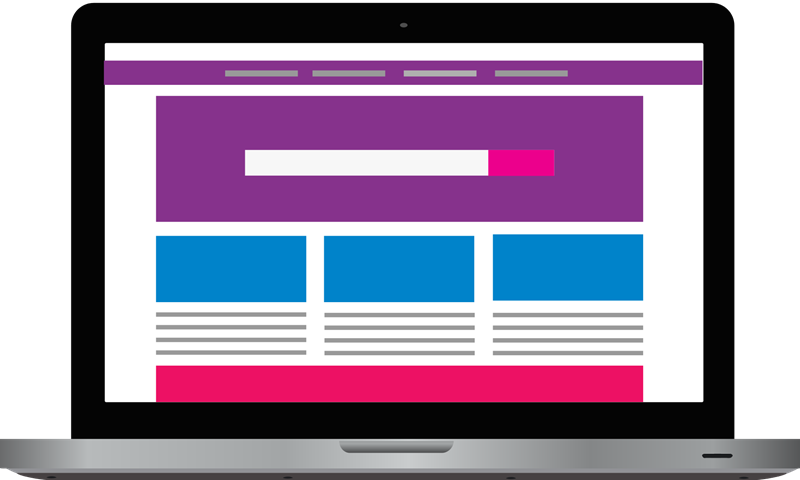The home page is often the first page people see when they hit your website.
This makes it extremely important to get right.
You need to hook them in and provide them with the information they need so they want to (and can) contact you.
We’ve developed hundreds of websites and here are some of the common mistakes we’ve seen people make and how you can fix them on your website.
1. It’s not clear what you do
You stumble upon someone’s website. It’s beautifully designed but, for the life of you, you can’t work out what actually do.
It’s amazing how often this happens.
After all, the first job of your website is to tell people what your business is about. There’s no need to be clever or mysterious – this isn’t the start of a thriller novel (unless your website is promoting your new thriller novel…).
So, clearly and concisely, in as few words as possible, tell people what you do.
This called a position statement.
For example, ours is, “We put big web solutions within reach.”
Ideally, you should use no more than 7 or 8 words and you should focus on what you can do for your customer.
2. Not mobile-friendly
Yes, it’s 2018, but not everyone has got the message that your website must be mobile-friendly.
According to Statista, over 50% of global web traffic came from mobile devices.
So, one out of every two people who visit your website will be doing so on a mobile device.
And these people need just as good of an experience as visitors viewing your site on a desktop. If people find your website difficult to use on their mobile, they’ll leave and check out your competitors.
Saying goodbye to 50% of your traffic is a huge missed opportunity!
Also, when we say mobile-friendly, we don’t just mean that your site shrinks down to fit the viewer’s device but that everything still looks good and functions correctly.
If you just purely scaled your website down, the fonts would become too small to read and buttons too difficult to tap.
Instead, make sure the font sizes, spacing, images, and buttons look good and are large enough on different sized devices. If they aren’t, adjust them.
3. Too much information
People don’t have time to read heaps of content and they are, most likely, only interested in one or two of your products or services and not everything you do.
Think of your home page like the reception area of your website. People arrive and are then directed to the page that has the information they are after.
If it takes to long for them to find out where to go they’ll just leave.
Clear call to actions are the best way to point your website visitors in the right direction.
4. No call to actions
Have you ended up on a website, been given a whole bunch of information, and then not sure where to go next?
That website forgot to add calls to action.
People don’t have time to figure out how to navigate your site, they want to be clearly led through it to find the information they are interested in and, once they’ve got that, how to contact you.
So, make sure you have signposted your website with clear calls to action that people can click to take them to where they (you!) want them to go on your website.
This starts at your home page. They’ve landed on your website and know what you do from your position statement, now you need to send them to the next page they’d be interested in – such as a product or service page.
5. Slow to load
A common theme has been popping up with each of these and that revolves around time. Your potential customers are busy.
Being clear about what you do, making it easy for them to navigate your site and find what they are looking for, whether it’s on mobile or desktop, all helps.
However, if your home page is too slow to load, you’ll lose people before they even see your site.
Google recommends your page load time should be under 3 seconds. However, they found that 70% of pages took 7 seconds to load.
Here’s how load times affect whether people will stick around or leave (bounce):
- 1s to 3s the probability of a bounce increases 32%
- 1s to 5s the probability increases 90%
- 1s to 6s the probability increases 106%
- 1s to 10s the probability increases 123%
There are a number of ways that your web developer can optimise your site, so it loads quickly and stops your visitors bouncing.
6. There are no contact details
It sounds obvious, but people do forget to include their contact details on their home page.
Yes, you’ll most likely have a Contact Us page that has them all on it, but if the majority of your visitors are landing on your page first you want them to be able to contact you as easily as possible.
After all, if they can’t contact you (or it’s too hard to figure out) then you’re missing out on business.
However you want to be contacted, make sure these details (normally phone or email address) are clearly displayed on your home page.
They should also be clickable. This is particularly important on mobile, so someone can click on your phone number and get redirected to their calling app to give you a call.
Conclusion
With so much of your website traffic hitting your home page first, it’s critical you’re providing them with the best experience, so they stick around and can be converted into a prospect.
Make sure it’s clear what you do and have a mobile-friendly, fast loading site with not too much information and clear calls to action and contact details.
At System 7, we can help you get your home page right before you launch your new website – get in touch.
Want more from your website?
Get practical, easy to implement guidance and tips to accelerate your online performance with a personalised one on one phone consultation







 The Risks of Having An Out of Date Website
The Risks of Having An Out of Date Website
 How to Use Marketing Buyer Personas to Improve the Effectiveness of Your Website
How to Use Marketing Buyer Personas to Improve the Effectiveness of Your Website
 How Marketing Has Changed in 2021
How Marketing Has Changed in 2021